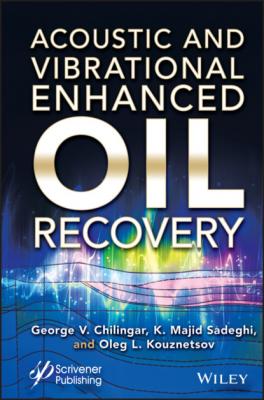Acoustic and Vibrational Enhanced Oil Recovery. George V. Chilingar
Чтение книги онлайн.
Читать онлайн книгу Acoustic and Vibrational Enhanced Oil Recovery - George V. Chilingar страница 19
 fields for assigned frequencies enable computation of the fields of vibrational displacements and vibrational accelerations.
fields for assigned frequencies enable computation of the fields of vibrational displacements and vibrational accelerations.
2.3 Wave Spreading From the Vibrating Surface of the Reservoir Matrix Into the Saturated Medium
Currently, the problem of wave propagation from the vibrating surface of the reservoir matrix into the various media has not yet been satisfactorily solved.
The motion of a viscous incompressible liquid filling half-space over the flat surface performing extension vibrations has been the earliest considered by Stokes.
A corresponding solution of the linear problem is easily generalized for a case of periodic vibrations [11].
We will review first a case of a horizontal fracture in the reservoir when it is performing straight-linear incremental harmonic vibrations in the same plane:
(2.21)
where η is the vibration velocity of the horizontal surface, V0 is its amplitude, and ω is the vibration frequency.
For the velocity of uncompressible liquid over a vibrating surface V = V(x, t) from the Navier-Stokes equation:
where v is kinematic viscosity factor. Equation (2.22) is similar to the diffusion and heat-conductivity equations. Boundary conditions of the problem are
where h is the facture width.
The first equality is the condition of a liquid sticking to the surface. The stationary solution of Equation (2.22) satisfactory to the conditions Equation (2.23) is [2, 3]:
where
(2.25)
Stokes solved this problem for a case of h → ∞:
It follows from Equation (2.26) that the facture’s surface involves the liquid in a vibratory motion with the same frequency ω and with the amplitude rapidly (exponentially) declining with distancing from the surface. The thickness δ of the liquid’s layer involved in vibration by the fracture surface due to liquid’s viscosity may be described by a distance at which the velocity amplitude is equal to 5% of its value on the fracture’s surface. This s a value determined, according to Equation (2.26), as
Here, the value
At viscosity factor v = (1.007–1.519)·10−2 cm2/s (which corresponds to water temperature change from 20° to 50°) and the vibrations frequency 2.5 to 5 Hz, the penetration depth is about 1 mm, which, is quite commensurate with the fracture width.
Figure 2.3 includes distribution diagrams of nondimensional vibratory velocity amplitudes of liquid
Figure 2.3 Vibration velocity distribution in a fracture (solid curves) and over a free surface (dashed line).
In a finite thickness layer above the harmonically vibrating fracture surface, for which βh ≥ c ≈ 3.69 (where c is the root of equation sh2c + ch2c = 400), and the penetration depth determined as previously is somewhat greater than the value δ = 3/β, but does not exceed the value c/β which it assumes at βh = c. In layers where βh = c, the 20-fold decline in the velocity amplitude is not reached.
Due to linearity of the problem, the above results are easily generalized for cases of rectilinear periodic arbitrary vibrations and periodic vibrations in two mutually perpendicular directions on the fracture surface.
At periodic rectilinear motion of the fracture surface (represented by a sum of harmonics with the frequency kω, where k 1, 2, …), the penetration depth for some mth harmonic, according to Equation (2.27), will be